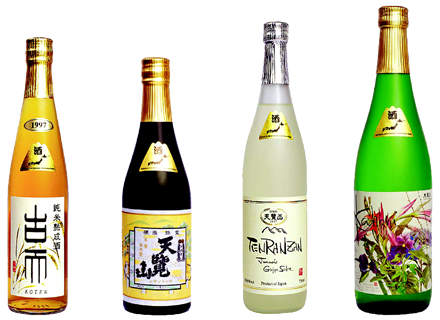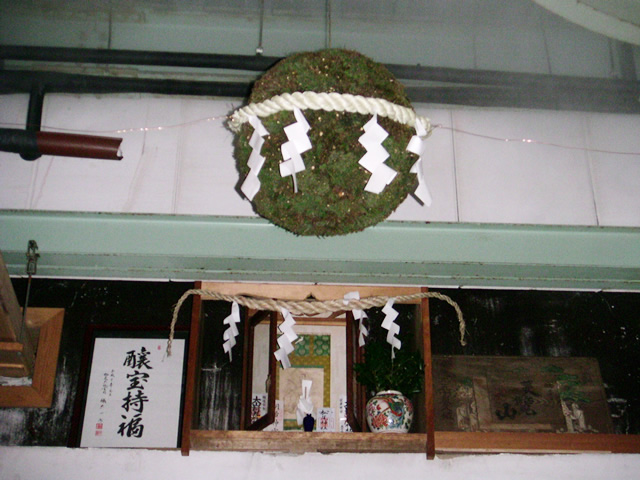Tenranzan JAPANESE SAKE
Igarashi syuzo co., ltd.

We were established in 1897, we were at first a small family owned brewery, and we have grown considerably over the decades. We created the Tenranzan brand name to personify our sake. The name 'Tenranzan' means 'The emperor mountain'. It's nearyby from the brewery. Our brewery is located in central Japan's Hanno-city, in the prefecture of Saitama. It's an area blessed with lush and beautiful natural reserves, fine water, two riverds and mountains.
How to make SAKE
Sake is made from rice, water, malt, and yeast. Rice used to brew Sake is a special kind called Saka-mai which contains very little protein oil, So Saka-mai dose not taste good at if one eats, but makes fine Sake. We use Yamada-nishiki, Gin-ginga, and Miyama-nishiki. Saka-mai and of course our sake is brewed by a Nanbu-toji.
1st step
Multiplying Koji(malt)and Kobo(yeast)
- Wash and hull the rice until the grains are polished to prepare it for brewing premium sake. [1] The rice in water for one day. [2] Steam the rice. (Mushimai) [3] Dry the rice.
- Mushimai([2] rice)into the room called Kojimuro, In Kojimuro, Mushimai is mixed with Koji(malt), where enzymes convert starch to glucose and are responsible for sake aroma and taste. The temperature of Kojimuro is always kept at 30 and the moisture of the room is also controlled carefully in order to stimulate the multiplication of Koji.
- Small portion of Mushimai is mixed with Koji-rice and water, and injected with Kobo(yeast) to make a seed mash called Syubo or Moto in the room Moto-ba.Kobo propagates itself by taking nourishment from Koji-rice.Multiplying Koji and Kobo processes are the most important part in brewing sake. Therefore, specialists called Koji-ya and Moto-ya are engaged in these processes.
2st step
Shikomi(mixing Mushimai(steamed-rice), Koji-rice, Syubo(yeast), and Shikomi-mizu(water
used for fermentation) )
- The rest of Mushimai is mixed with the Koji-rice, Syubo, and Shikomi-mizu in a huge tank called Shikomi tank.
In this tank, starch of Mushimai is converted into fermentable glucose by Koji-rice, and the glucose is changed into alcohol and carbon dioxide gas by Syubo. This change is called Hakko (fermentation). Hakko completes when the bubbles which are formed by carbon dioxide gas stop appearing. Fermentation period for sake is about 20 - 30 days. During this period, sake making specialists called Toji. Toji meaning 'master brewer'. Toji is always keep eyes on conditions of bubbles in tank in order to give proper directions to other workers. Toji continue wake up at fixed times even during night-time to check the conditions in the tank.
3rd step
Shibori(squeezing Moromi)
- When fermentation (Hakko) is completed, the mash is white and mushy. This mash is then squeezed and parted into Sake and Sake-kasu. Sake at this stage is called Shiboritate. (fresh sake). But fermentation may take place in Shiboritate. So Shiboritate goes through filtration and heat treatment in order to kill the multiplying power of Syubo.(Shiboritate is sold only during winter.)
SAKAGURA(Sake brewery)
Sake is one of most sensitive liquor in the world as well as wine, also, it can be brewed only during winter. In order to sell Sake throughout a year, Sake brewers build Sakagura and store Sake in them. In Sakagura, the temperature change is very little. It is said that Sakagura keeps cold air of night even summer. In old days, Sake was stored in wooden tanks in Sakagura. But today, it is stored in poroelain enamel tanks.
SAKABAYASHI

Sakabayashi is a sign let customers know that new Sake and Sakagura(brewers grains) are ready for sale. Sake can be brewed only during winter as it needs to be fermented for a long time at low temperature.
In old days, people bought Sake at Sake breweries as there were very few stores that carried Sake, so, seeing a new Sakabayashi, people know that new Sake was ready. Today, people buy Sake at stores. So, Sakabayashi has no practical meaning. But Sake brewers still continue to hang a new Sakabayashi when new Sake is made as one of their celebrating ceremonies. Brewing of Sake starts around the end of October at Igarashi-Syuzou every year and new Sake is made around the end of November or the beginning of December.
667-1, Kawadera, Hanno-shi, Saitama-ken, 357-0044
Tel:042-973-7703 Tel(shop):042-974-7788